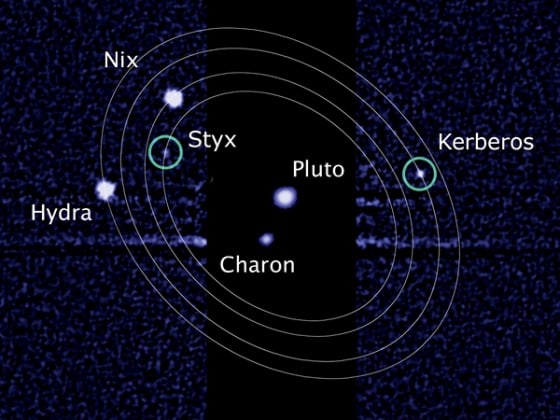Pluto's five moons give the dwarf planet more satellites than Mercury, Earth, Venus and Mars combined — and scientists are zeroing in on the explanation for that. They say it all goes back to a cosmic billiards game that began 4 billion years ago.
The biggest moon of the five, Charon, is so massive and so close to Pluto that some astronomers think the two worlds should be considered a double-planet system. The smaller moons — Styx, Nix, Kerberos and Hydra — have orbital periods that are almost exactly three, four, five and six times as long as Charon's. And they're placed much farther out than scientists would expect, based on computer models of planetary formation.
"Their distance from Pluto, and the orbital arrangement of the satellites, has been a challenge for theories of the small satellites' formation," Hal Levison, a scientist at the Southwest Research Institute's Planetary Science Directorate in Boulder, Colo., said in a news release.
Now Levison and a colleague of his at SwRI, Kevin Walsh, have come up with a model that explains why Pluto has so many moons, so far out. The trick is that Pluto started out with even more satellites that smashed into each other repeatedly over the course of a million years or so.
Scientists have long thought that Charon was formed 4 billion years ago, out of the debris from a collision between Pluto and some other world from the ring of icy objects beyond the orbit of Neptune.
Levison and Walsh developed a computer model that starts out with many more pieces of debris. The first generation of small satellites would be destroyed through collisions with each other and with Pluto and Charon — but the resulting debris would become the starting point for a fresh batch of satellites, thrown farther out from Pluto by the collisions as well as Charon's gravitational slingshot effect.
Eventually, the cycles of crashes and recombinations would produce a troop of mini-moons that stay out of each other's way — and out of Charon's way, due to the 1:3:4:5:6 orbital resonances between them. A similar type of resonance, of the 2:3 variety, explains why Pluto and Neptune can co-exist even though their orbits cross.
"The implications for this result are that the current small satellites are the last generation of many generations of satellites," Walsh said. "They were probably first formed around 4 billion years ago, and after an eventful million years of breaking and rebuilding, have survived in their current configuration ever since."
Levison and Walsh say their model doesn't completely clear up the mystery. For example, the theoretical resonances don't seem to be as "sticky" as the reality that governs the orbits of Pluto's moons. "We have not been able to put together a complete picture," they say in their presentation for the Denver meeting.
The research was funded by a grant from NASA's Outer Planetary Research program and Lunar Science Institute, and presented Thursday in Denver at a meeting of the American Astronomical Society's Division for Planetary Sciences. The work took advantage of the Extreme Science and Engineering Discovery Environment digital collection, which is supported by the National Science Foundation.
More about Pluto:
- Pluto-bound probe spots its target
- Flash interactive: The new solar system
- Pluto may have 10 more moons
- NBC News archive on Pluto
Alan Boyle is NBCNews.com's science editor. Connect with the Cosmic Log community by "liking" the NBC News Science Facebook page, following @b0yle on Twitter and adding +Alan Boyle to your Google+ circles. To keep up with NBCNews.com's stories about science and space, sign up for the Tech & Science newsletter, delivered to your email in-box every weekday. You can also check out "The Case for Pluto," my book about the controversial dwarf planet and the search for new worlds.
